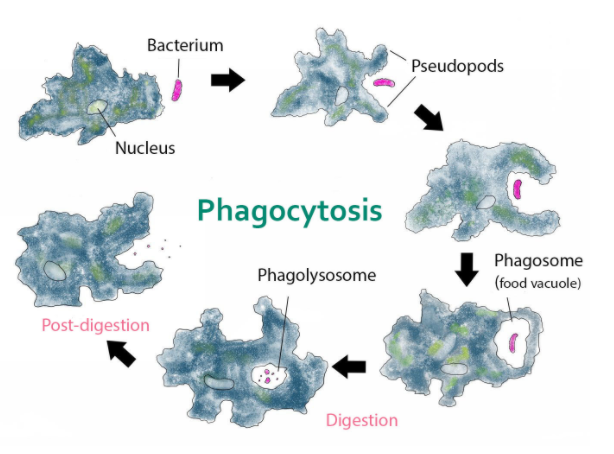
How is the amoeboid shape of WBCs helpful to them?
Answer
425.1k+ views
Hint: White blood cells, often called leukocytes or leucocytes, are immune system cells that assist the body fight infection and foreign invaders. Both white blood cells are formed and generated from hematopoietic stem cells, which are multipotent cells in the bone marrow.
Complete answer:
While white blood cells make up just about 1% of your blood, they have a significant effect. Leukocytes are another name for white blood cells. They guard you against disease and illness.

Consider white blood cells to be the immune system's first line of defence. They are still at war, in a sense. They circulate in your bloodstream to combat viruses, bacteria, and other foreign invaders that pose a health risk.
White blood cells rush in to help remove the toxic material and avoid infection when the body is in pain and a specific region is under attack. The bone marrow is where white blood cells are made. They are contained in the blood and lymphatic tissues of the body. Since neutrophils, a type of white blood cell, have a brief life span of less than a day, your bone marrow is constantly producing them.
WBCs have an amoeboid form that helps them squeeze through the capillary wall.Our body's soldiers are white blood cells. They play a crucial role in the defence system. White blood cells congregate at the site of infection to kill pathogens. Their amoeboid form allows them to squeeze through blood capillaries while their pseudopodia aid in the phagocytosis process, which kills pathogens.
Our body's defence mechanism is supported by white blood cells. They play a crucial role in the removal of foreign particles. White blood cells gather at the site of infection to kill pathogens.
Their amoeboid form allows them to squeeze through blood capillaries while their pseudopodia aid in the phagocytosis process, which kills pathogens. They alter their form to sink bacteria and isolate invaders in the body, protecting the body from diseases and infections.

Note: White blood cells have a lifespan of 13 to 20 days, after which they are killed by the lymphatic system. "Bands" or "stabs" are the names given to immature WBCs that are released from the bone marrow into the peripheral blood. Phagocytosis is a mechanism by which leukocytes battle infection. The leukocytes surround and kill foreign species during phagocytosis. As part of the body's immune response, white blood cells often generate, transport, and spread antibodies.
Complete answer:
While white blood cells make up just about 1% of your blood, they have a significant effect. Leukocytes are another name for white blood cells. They guard you against disease and illness.

Consider white blood cells to be the immune system's first line of defence. They are still at war, in a sense. They circulate in your bloodstream to combat viruses, bacteria, and other foreign invaders that pose a health risk.
White blood cells rush in to help remove the toxic material and avoid infection when the body is in pain and a specific region is under attack. The bone marrow is where white blood cells are made. They are contained in the blood and lymphatic tissues of the body. Since neutrophils, a type of white blood cell, have a brief life span of less than a day, your bone marrow is constantly producing them.
WBCs have an amoeboid form that helps them squeeze through the capillary wall.Our body's soldiers are white blood cells. They play a crucial role in the defence system. White blood cells congregate at the site of infection to kill pathogens. Their amoeboid form allows them to squeeze through blood capillaries while their pseudopodia aid in the phagocytosis process, which kills pathogens.
Our body's defence mechanism is supported by white blood cells. They play a crucial role in the removal of foreign particles. White blood cells gather at the site of infection to kill pathogens.
Their amoeboid form allows them to squeeze through blood capillaries while their pseudopodia aid in the phagocytosis process, which kills pathogens. They alter their form to sink bacteria and isolate invaders in the body, protecting the body from diseases and infections.

Note: White blood cells have a lifespan of 13 to 20 days, after which they are killed by the lymphatic system. "Bands" or "stabs" are the names given to immature WBCs that are released from the bone marrow into the peripheral blood. Phagocytosis is a mechanism by which leukocytes battle infection. The leukocytes surround and kill foreign species during phagocytosis. As part of the body's immune response, white blood cells often generate, transport, and spread antibodies.
Recently Updated Pages
Master Class 10 General Knowledge: Engaging Questions & Answers for Success

Master Class 10 Computer Science: Engaging Questions & Answers for Success

Master Class 10 Science: Engaging Questions & Answers for Success

Master Class 10 Social Science: Engaging Questions & Answers for Success

Master Class 10 Maths: Engaging Questions & Answers for Success

Master Class 10 English: Engaging Questions & Answers for Success

Trending doubts
A boat goes 24 km upstream and 28 km downstream in class 10 maths CBSE

Why is there a time difference of about 5 hours between class 10 social science CBSE

The British separated Burma Myanmar from India in 1935 class 10 social science CBSE

The Equation xxx + 2 is Satisfied when x is Equal to Class 10 Maths

Chandigarh is the capital of A Punjab B Haryana C Punjab class 10 social science CBSE

Change the following sentences into negative and interrogative class 10 english CBSE




